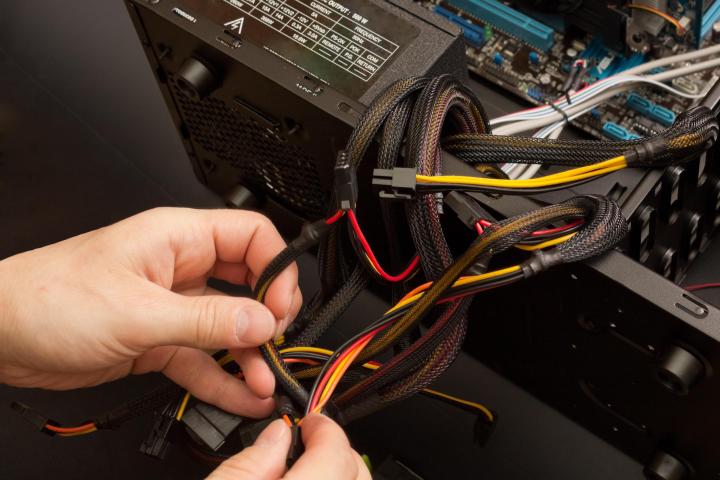I never think about the power supply in my gaming PC. It’s an 850W bequiet! Straight Power that I’ve owned for years and transferred between several builds.
Like most PC builders, I intended to replace it once it had reached its end of life, which would mean I have a few more years before that becomes a problem. That is, with the hardware I have now.
We’re standing on the edge of the next generation of GPUs from AMD and Nvidia, and all signs point to them drawing more power than ever before. As innocuous as the best PC power supplies are, PSUs are primed to see lower supply and higher prices when next-gen GPUs arrive, especially if a lot of builders need to upgrade. It’s been easy to ignore your power supply for the better part of a decade, but that time is coming to an end.
A decade of solitude

For around a decade, a 750W power supply has been more than enough for even the highest-end gaming PCs. Nvidia’s GTX 690, which launched around 10 years ago, topped out at 300W, and Intel’s highest-end Sandy Bridge-E chip went up to 130W. Since then, power demands have stayed relatively stable, and in many cases, have gone down.
So, if you bought a 750W power supply with a 10-year warranty (Seasonic, Corsair, and EVGA, among others, offer 10-year warranties on many PSUs) a decade ago, there hasn’t been a reason to upgrade. That’s changing. Nvidia, AMD, and Intel are pushing power ranges to highs we’ve never seen before.
This is the first time in a long time that components are forcing an upgrade.
The current generation shows plenty of signs of that. The RTX 3080, for example, is the first GPU in its class to push past the 250W mark, and the RTX 3090 Ti is the first consumer GPU to ever go past 400W. Similarly, Intel’s Core i9-12900K can draw around 240W when it’s boosting, nearly doubling the power draw of previous generations. I don’t know what’s in store for Ryzen 7000 yet, but the Ryzen 7 5800X3D already showed that AMD’s designs could have higher thermal and power demands in the future.
750W is no longer enough for a high-end gaming PC, even if companies like Nvidia suggest that it is (that is the official PSU recommendation for the RTX 3090, after all). Although replacing your power supply for higher efficiency or cycling out a unit that has reached its end of life is a good idea, this is the first time in a long time that components are forcing an upgrade. And that’s looking increasingly true for the next generation.
The problem isn’t that you might have to replace your PSU with next-gen upgrades — it’s that we could see power supply shortages and increased prices. If you want to upgrade when next-gen CPUs and GPUs roll around, the time to upgrade your power supply is now.
Don’t wait for prices to go up

We’re staring down the barrel of the RTX 40-series and RX 7000, both of which are rumored to come with extremely high power demands. Some leakers say the RTX 4090 could draw as much as 600W, and although we haven’t heard about AMD’s RX 7000 cards yet, the current-gen RX 6000 cards are already pushing power to heights AMD has never gone before.
Waiting until next-gen parts show up may be too late, though. The beginning of 2020 brought on a power supply shortage due to the pandemic, which continued throughout the year on the back of increased demand from cryptocurrency miners. That’s not to mention builders upgrading their PSUs to accommodate a new graphics card that draws more power.
We don’t have a pandemic to contend with in 2022 — at least, not in full force — but that doesn’t mean demand for power supplies won’t go up. If the rumors are true about the power demands of next-gen components, I’d wager a lot of folks resting on the adage that 750W is enough will be looking for an upgrade.
Power supplies will almost certainly see increased prices.
Don’t discount cryptocurrency mining, either. Although Ethereum has fallen off, it could spike again. Proof of Stake has been perpetually delayed, and we have two generations of history showing what happens when new GPUs launch. I certainly hope miners won’t buy up next-gen cards and power supplies with them. But based on the last two generations, it’s a safer assumption than assuming GPUs and power supplies won’t sell out.
Prices are another big factor. Although there’s a solid chance we won’t see a PSU shortage like the one at the beginning of 2020, we will almost certainly see increased prices. Right now, during the lull before next-gen GPUs show up, power supplies are cheaper than they were even six months ago.
| November 18, 2021 | May 18, 2022 | Percentage change | |
| EVGA SuperNOVA GA 850W | $130 | $90 | -30.8% |
| Corsair RM850x | $135 | $125 | -7.4% |
| Seasonic Focus GX 1000W | $120 | $200 | 66.7% |
| Corsair RM750 | $110 | $105 | -4.5% |
| EVGA SuperNOVA G6 1000W | $230 | $175 | -23.9% |
Source: PC Part Picker
There are some power supplies that are more expensive — Seasonic PSUs, in particular, are consistently more expensive than they were six months ago — but many of the most popular options are as much as 30% cheaper than they were late last year. New power supplies are seeing discounts, too. The recently launched Gigabyte Aorus P1200W, for example, is down to $310 after launching less than a month ago near $380.
The prices six months ago weren’t the peaks for these power supplies, either. Corsair’s RM750 has sold for as much as $130, for instance, and the EVGA SuperNOVA GA 850W sold for between $140 and $160 for the majority of 2021. Once demand spikes with new GPUs, prices could return to these peaks.
What I recommend

You should buy a new power supply if you plan on upgrading to a next-gen GPU before they arrive. That could be now, especially if you’re sitting on a power supply that’s getting older, or it could be after Nvidia and AMD finally pull back the curtain on our next generation of options. Just don’t wait until you’re picking up a new GPU, where you’ll likely pay a premium for a part you can get cheaper now.
This is the perfect time to start thinking about what you want, too. If you’re reading this the day it’s published, Computex is starting tomorrow. Given that the well of refreshes has run dry for AMD and Nvidia, I expect we’ll see a glimpse at the next generation. And that means a PSU upgrade is in order.
This article is part of ReSpec – an ongoing biweekly column that includes discussions, advice, and in-depth reporting on the tech behind PC gaming.





